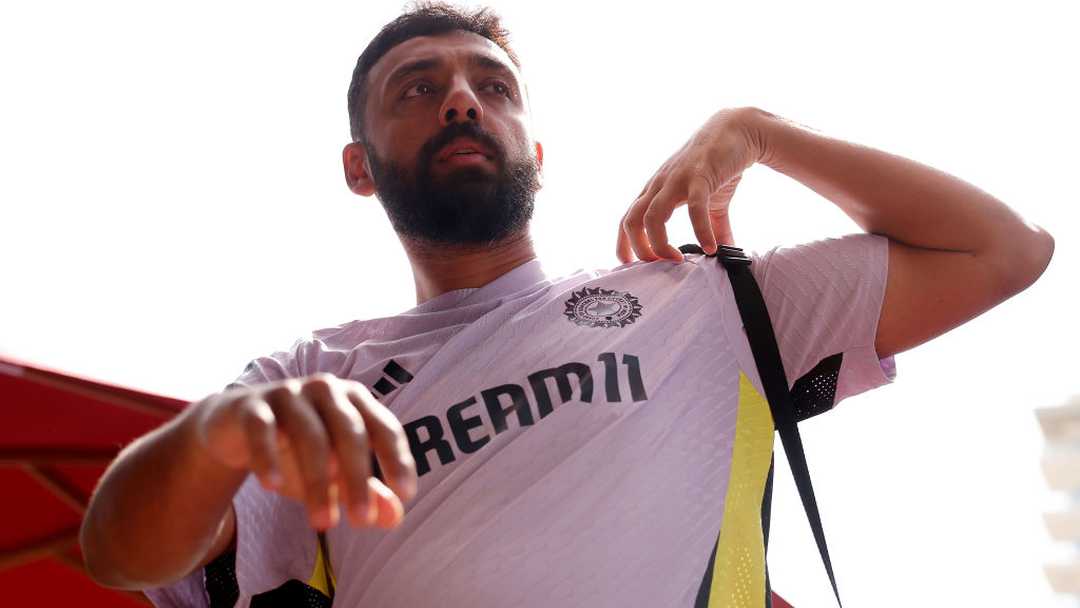
Namma jeichitom, Maara: Varun Chakaravarthy's second flight
Varun Chakaravarthy was sure his time had come again. He had already been asked for his Adidas sizes. Shirt, trousers, tracksuit: all ticked off, as if the place in India's squad was a formality. It was July 2024, and India were preparing to send a second-string team to Zimbabwe after the T20 World Cup win. Varun fit that mould better than most: more than 40 wickets across two IPL seasons, a title with Kolkata Knight Riders, the reputation of a bowler trusted in the toughest overs.
Then the squad came out. His name wasn't there.
The hurt cut deeper than usual. This time it wasn't about form or figures; it was about how much he had already rebuilt. After the horror of the 2021 World Cup, when he went wicketless in three games and came back home to a torrent of online abuse, and the slump of 2022, when KKR dropped him midway, he had stripped everything back. He changed his run-up, reworked his delivery stride, moved from sidespin to overspin and even overhauled his stock ball.
The scars went further back, though. They stretched back to every false start from his earlier years. He had tried being a wicketkeeper, a pace bowler, an architect, a freelancer, even flirted with films for a bit. None of those lives fit him and every switch left a bruise.
Then, one afternoon in 2017, Varun rang Baba Aparajith with a blunt announcement: "I'm a mystery spinner now." The Aparajith twins only knew him as a fast bowler, a regular net trundler. Intrigued, they went to the Gandhi Nagar nets in Adyar to have a look.
What they found baffled them.
"We didn't know if it would work in a proper game," Indrajith recalls, "but in the nets he was really impressive and we were not able to read him easily."
It sounded audacious, even absurd. A pacer-turned-architect announcing himself a mystery spinner? But this new hat stuck.
So when he sat across from AC Prathiban in a Chennai cafe after a poor IPL season in 2022, coffee in hand, and asked without pretence, "Do you think I can play for India?" — it wasn't a casual query. He had already played for India. Which made the question more than a passing query. It was existential.
Prathiban, who first met Varun at the Madurai Panthers in 2022 before taking him on as a personal trainee, didn't mince words. "I told him, if you can take 20 wickets in an IPL season, then you'll get your chance. That's all."
He did it. 20 wickets in 2023, 21 in 2024. The numbers were there and yet, he was not on the plane to Harare. This time the criticism that trickled back was not about his bowling. He was told his fielding was not good enough.
A few days after the snub, Varun found himself playing for Dindigul Dragons in the Tamil Nadu Premier League. One quiet evening, he was hanging out with the team's fielding coach Ashok Kumar, or 'Diamond' as Varun called him, in his room and let out what had been gnawing at him all these days.
Diamond listened, then cut through the frustration with a simple truth.
"Varun, ippo namma kitta edhana onnu illa," he told him. "If something is missing, we have to fix it. If we improve that aspect, then none will ask you questions, no one will say you are not good enough."
Diamond was clear the issue with Varun's fielding was awareness, not hands. "He has always been a good catcher," Diamond says. "The problem was that if his batting went badly in the first innings, he would be sad and switch off in the field later."
So Diamond began filming him during the matches. Afterwards they sat down, froze the footage and compared the two Varuns: one walking in, alert and ready; the other flat-footed and a beat late.
"I told him, see here," Diamond says. "This ball you are walking in, aware, ready. The next ball you are standing still, not reacting. That is why you miss. You cannot do that. You have to walk in every ball. 120 balls, 120 times. Be in the game always."
They practised where he would actually field for India or in the IPL: short third, short fine, long off. Diamond set cones fifteen yards in front and fifteen yards to the side. The drills were simple and brutal: walk in, attack the ball and fire flat to the keeper.
Varun asked for even harder sessions. "He told me, 'Diamond, don't make it normal. Make me tired,'" Diamond recalls, and smiles. So Diamond made him tired.
The improvements, working in sync with the sessions Varun was putting in with the Strength & Conditioning (S&C) coach, came in small bursts.
After every good save or catch, he'd find Diamond, still panting, and say their private line: "See? Look what I did there."
A sharp take at fine leg in the IPL followed before larger recognition arrived. When he was named the Player of the Series against England in February 2025, he was glad that his fielding also "drew some applause." The award, of course, was for his bowling.
Fielding had been the last box to tick, the thing that finally got him into the squad. But the reason he could walk in and flourish straightaway with five-wicket hauls in Gqeberha and Rajkot was because of the heavier work, the technical rebuild with Prathiban that had begun two years earlier.
The work had started with a realization that a delivery that was once the centrepiece of his "mystery" now skidded and offered little. His carrom ball wasn't turning enough. And if the googly, his best ball, was to stay his main weapon, he needed a reliable away-going ball to set it up.
That's when he went back to Prathiban in earnest.
"I will be honest, it was his idea of getting that leg-spinner," Prathiban says. "He had a couple of grips, and I asked him whether he wanted to stick with the carrom ball, which was his top ball until then. But I couldn't see any deviation off the wicket, it wasn't effective enough to take it away. So I told him, what else do you have? He came with a couple of options, and one of them was the leg-spinner."
They tried options in Chennai's nets and almost immediately the difference emerged. Under pressure, the legbreak held up better. "When the pressure came, only the leg-spinner was coming out well," Prathiban remembers. "So we said, this is the one."
At first he bowled it seam-up: conventional, neat. But it turned out the seam itself was a cue. High-level batters could read the seam and predict the spin. Legbreak was seam-up, googly was scrambled. "We need to upgrade ourselves. You need to go scramble leg spinner," Prathiban told Varun. And it worked wonders.
That scrambled-seam legbreak was a small surface trick with an outsized consequence but it was only half the story. Prathiban pushed Varun to think about the axis. "So, basically, side spin for the away-going delivery, it comes front of the hand. I mean, you can see the entire ball. Basically, when the ball is being released, the back of the palm is always facing the sight screen and you can see the ball entirely as a batter. When it's overspin, it's always behind the fingers so you don't see the ball. Basically, you cut down by 0.5 seconds for the batter to read."
Half a second is a lot in cricket. With the ball hidden behind the fingers, the batsman loses the micro-cues that tell him whether the ball will straighten or turn. What helped further was that Varun could bowl overspin not as a slow, languid loopy ball but at pace, with revs and pop. Prathiban is explicit on why that was unusual: "Nathan Lyon, Keshav Maharaj, even Adil Rashid, they bowl overspin, but not at that speed. Varun has this fast, vertical action. He can bowl overspin at good speed and still get bounce. That's very rare."
More revs at higher speed meant more bounce, and more doubt. For, not every pitch turns, certainly not in the IPL and international cricket.
While moving away from side-spin could look like a compromise on turning the ball, Prathiban explained that it's more complicated than that. "You bowl from the middle of the box and if the ball hits the off stump and if it's hitting the off stump, it has turned. When the angle is more, the turn will be less. If he comes a bit closer to the stumps, the angle is lesser so the turn is more. So, that becomes a natural variation. No T20 wickets in India will offer you a lot of turn."
For Varun, the combination of scrambled seam and quick overspin meant he could hide the wobble and then rely on height and angles at the crease to beat batters who had little time to adjust.
They tested the work in the hardest places first. On astroturf the ball skids; there is almost no natural turn. If his craft survived there, it would survive anywhere. "We imagine Buttler is batting, say," Prathiban says of the practice. "If the ball hits the right length and channel, we reckon it's a one-run ball. Even Varun's best ball there is never a wicket ball. If it doesn't hit the right length and channel, we count it as a boundary.
The sessions were not only technical but tactical. They talked about sequencing and match simulation. The coach's job, he says, is partly pruning: Varun wanted seven or eight weapons. Prathiban insisted on three or four that could be executed under duress. "The best defensive ball is the most attacking ball. If you can bowl that perfectly, the batsman will make the mistake."
It worked in the IPL: wickets followed, performances stacked up. In the circuit. In the
Everyone has ups and downs but this guy has seen a lot of downs. He has done a lot of things and everything was a failure and this hurt him.
A few weeks later, Varun was called for tests. He was expecting to be picked for the series and then go straight to the hotel after the tests at the National Cricket Academy (NCA). But instead, he was told to go home. He called Prathiban again. Frustrated. Emotional. But just as he was about to reach home, his phone buzzed. He had been picked. The coach did not talk about cricket. He reached for a line from Soorarai Pottru, a Tamil film both men knew by heart. "Namma jeichitom, Maara. We have won, friend.

